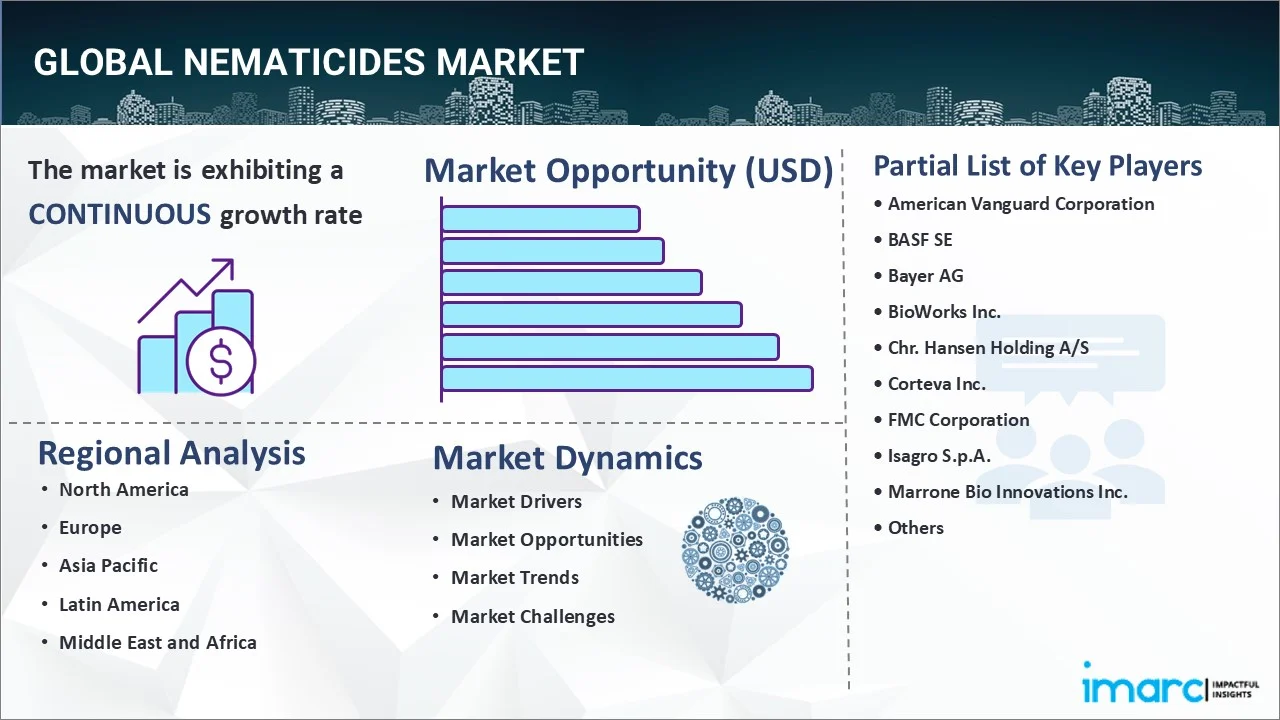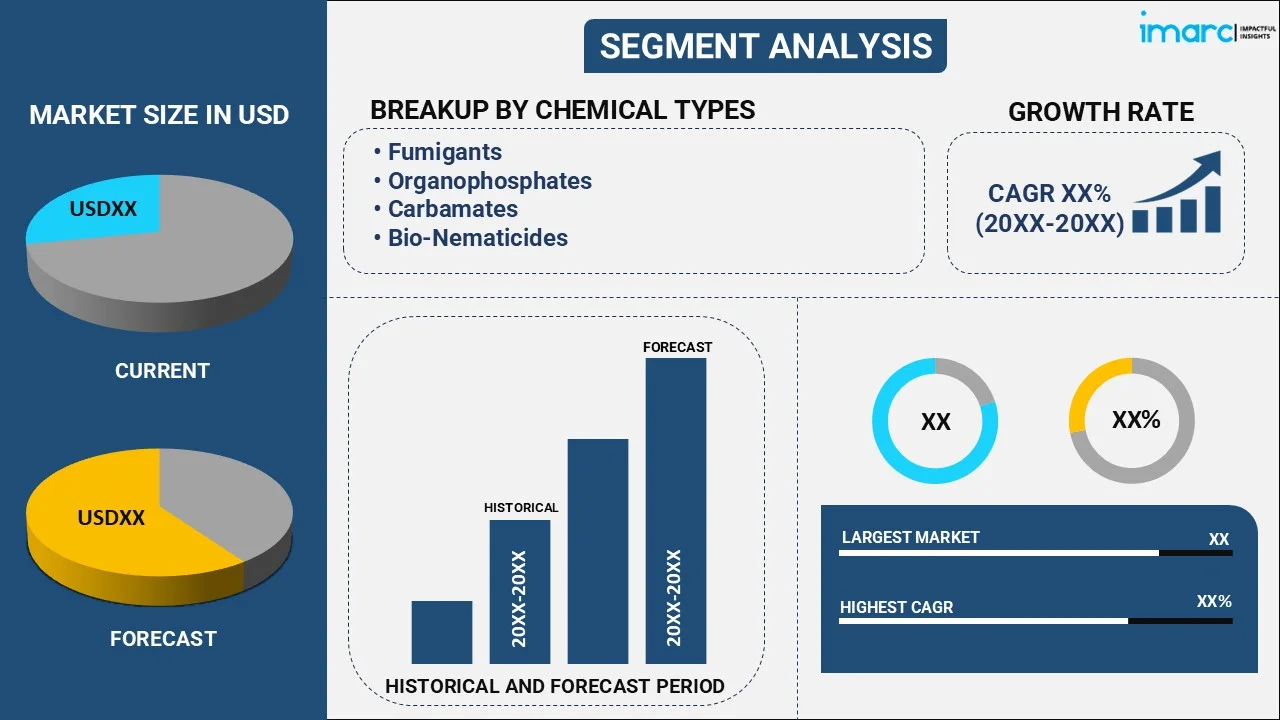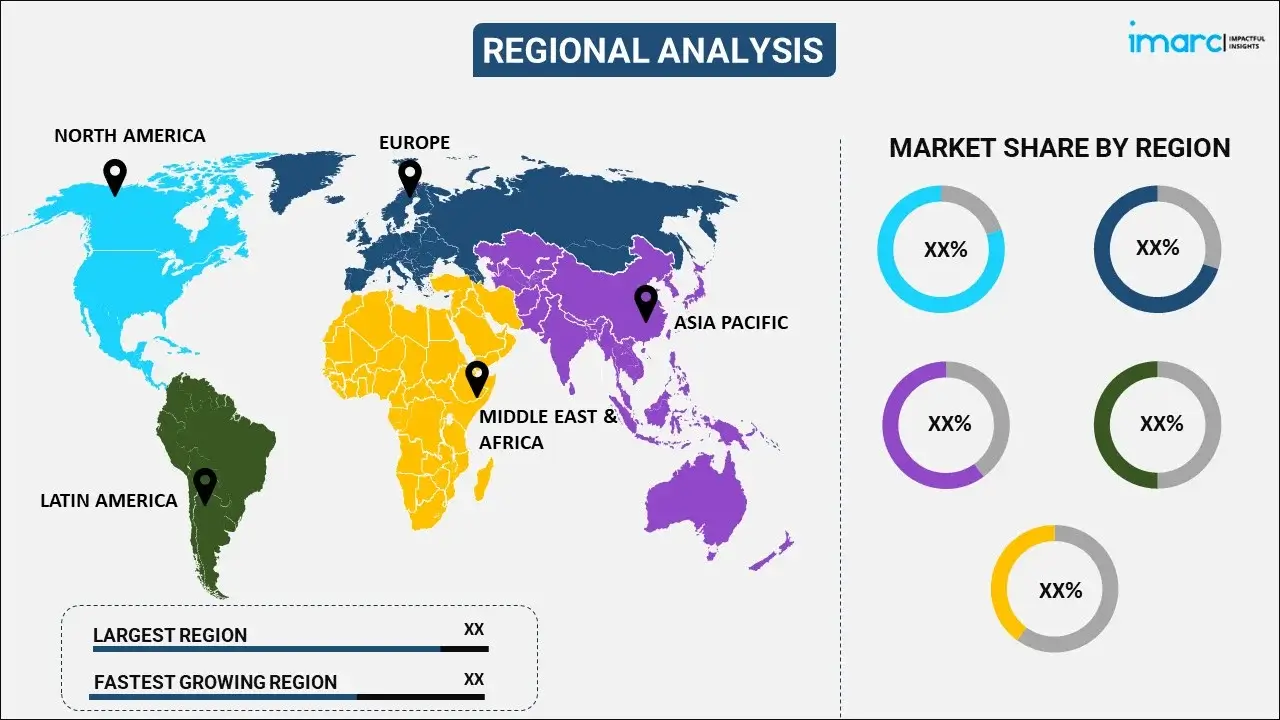
Nematicides Market Report by Chemical Type (Fumigants, Organophosphates, Carbamates, Bio-Nematicides), Nematode Type (Root-knot Nematode, Cyst Nematode, and Others), Formulation (Liquid, Granular, Emulsifiable Concentrates, and Others), Application (Grains and Cereals, Pulses and Oilseeds, Commercial Crops, Fruits and Vegetables, and Others), and Region 2025-2033
Market Overview:
The global nematicides market size reached USD 1.6 Billion in 2024. Looking forward, IMARC Group expects the market to reach USD 2.2 Billion by 2033, exhibiting a growth rate (CAGR) of 3.8% during 2025-2033. Increasing food demand due to population growth, climate-induced nematode infestations, stringent regulations promoting sustainable farming practices, innovations in nematicide formulations, expanding agricultural activities in emerging economies, adoption of precision agriculture, and collaborations among industry leaders are factors supporting the market growth.
|
Report Attribute
|
Key Statistics
|
|---|---|
|
Base Year
|
2024 |
|
Forecast Years
|
2025-2033
|
|
Historical Years
|
2019-2024
|
| Market Size in 2024 | USD 1.6 Billion |
| Market Forecast in 2033 | USD 2.2 Billion |
| Market Growth Rate (2025-2033) | 3.8% |
Nematicides are chemical agents specifically designed to control and mitigate the population of nematodes, which are microscopic roundworms that can be detrimental to various crops and plants. They serve a vital role in agriculture and horticulture by safeguarding plants from nematode-induced damage. Nematicides are employed primarily to enhance crop yields, maintain soil health, and protect plant root systems. Their advantages lie in their ability to prevent nematode infestations, which can otherwise lead to stunted growth, reduced crop quality, and economic losses for farmers. There are two primary types of nematicides: chemical and biological. Chemical nematicides consist of synthetic compounds formulated to target nematodes effectively. In contrast, biological nematicides employ naturally occurring microorganisms or substances derived from plants to control nematode populations.

The global nematicides market is influenced by the burgeoning global population and the consequent rise in food demand, which have necessitated higher crop yields. This is further bolstered by the escalating prevalence of nematode infestations in agricultural fields due to changing climate patterns. Moreover, stringent government regulations regarding pesticide usage and a growing awareness of sustainable farming practices have led to the adoption of eco-friendly nematicides, which is augmenting the market growth. Additionally, advancements in research and development (R&D) have paved the way for innovative nematicide formulations, further propelling market growth. Furthermore, the expansion of agricultural activities, coupled with the adoption of modern farming techniques, is driving the market growth.
Nematicides Market Trends/Drivers:
Increasing food demand and crop yields
The global nematicides market is strongly influenced by the increasing global population and its subsequent surge in food demand. As the world's population continues to grow, there is a pressing need for higher crop yields to meet this demand. Nematode infestations in agricultural fields pose a significant threat to crop productivity. Consequently, farmers are increasingly turning to nematicides to protect their crops and ensure optimal yields. This driver is underpinned by the critical role agriculture plays in ensuring food security worldwide. Sustainable agriculture practices and the responsible use of nematicides are pivotal in addressing this challenge and ensuring a steady food supply for the growing population.
Climate-induced nematode infestations
Another major driver of the global nematicides market is the escalating prevalence of nematode infestations in agricultural fields, which can be attributed to changing climate patterns. As global temperatures and weather patterns become more unpredictable, nematodes thrive in various regions, causing damage to crops. Farmers are compelled to seek effective nematicide solutions to protect their investments and maintain crop health. This driver underscores the importance of adaptive strategies in agriculture to mitigate the impact of climate change on crop production and global food security.
Regulatory environment and sustainable farming
Stringent government regulations regarding pesticide usage and a growing awareness of sustainable farming practices are pivotal drivers of the nematicides market. Governments worldwide are implementing stricter guidelines to ensure the responsible use of pesticides, including nematicides, to minimize environmental and health risks. Simultaneously, farmers are increasingly adopting sustainable and eco-friendly farming practices, including the use of organic and bio-based nematicides. This driver reflects the shifting paradigm towards environmentally responsible agricultural practices and the importance of nematicides that align with these principles, contributing to the growth of the global nematicides market.
Nematicides Industry Segmentation:
IMARC Group provides an analysis of the key trends in each segment of the global nematicides market report, along with forecasts at the global, regional and country levels for 2025-2033. Our report has categorized the market based on chemical type, nematode type, formulation, and application.
Breakup by Chemical Type:

- Fumigants
- Organophosphates
- Carbamates
- Bio-Nematicides
Fumigants dominate the market
The report has provided a detailed breakup and analysis of the market based on the chemical type. This includes fumigants, organophosphates, carbamates, and bio-nematicides. According to the report, fumigants represented the largest segment.
The growth of the fumigants segment is influenced by the increasing global food demand, driven by population growth. Fumigants offer an effective solution to control pests and pathogens in soil and stored commodities, thereby ensuring optimal crop productivity and food security. Moreover, growing concerns about food safety and quality have led to heightened regulations governing the use of fumigants in the food supply chain. Compliance with these regulations has become paramount for agricultural and food industry stakeholders, driving the demand for safe and approved fumigant products. In line with this, the increasing global trade in agricultural commodities has heightened the need for pest-free produce. Furthermore, advancements in fumigation techniques and formulations, such as the development of environmentally friendly and less-toxic fumigants, have expanded the range of applications and improved safety, further fueling market growth.
Breakup by Nematode Type:
- Root-knot Nematode
- Cyst Nematode
- Others
Root-knot nematode dominates the market
The report has provided a detailed breakup and analysis of the market based on the nematode type. This includes root-knot nematode, cyst nematode, and others. According to the report, root-knot nematode represented the largest segment.
The growth of the root-knot nematode segment in the nematicides market is propelled by the increasing occurrence of root-knot nematode infestations, which poses a significant threat to agricultural productivity, especially in regions with warm and humid climates. As these nematodes damage plant roots, farmers are increasingly seeking effective solutions to protect their crops, driving the demand for root-knot nematode-specific nematicides. Moreover, the rising adoption of integrated pest management (IPM) practices has led to a greater focus on nematode control. Root-knot nematodes are a prominent target in IPM strategies due to their adverse impact on crop health. Consequently, the demand for nematicides targeting this specific nematode type has surged. In line with this, the development of innovative and environmentally friendly formulations for root-knot nematode control is driving segment growth.
Breakup by Formulation:
- Liquid
- Granular
- Emulsifiable Concentrates
- Others
Liquid dominates the market
The report has provided a detailed breakup and analysis of the market based on the formulation. This includes liquid, granular, emulsifiable concentrates, and others. According to the report, liquid represented the largest segment.
The growth of the liquid segment in the nematicides market is influenced by the surging demand for liquid nematicides by farmers due to their ease of application and uniform distribution properties. This convenience factor drives demand as it simplifies the application process, making it more efficient. Furthermore, liquid nematicides offer faster absorption by plant roots, resulting in quicker nematode control and reduced crop damage. This rapid action is particularly crucial in areas with high nematode pressure. Additionally, the development of advanced liquid formulations with enhanced efficacy and reduced environmental impact has bolstered the adoption of liquid nematicides. These formulations often incorporate environmentally friendly ingredients, aligning with the growing trend of sustainable agriculture.
Breakup by Application:
- Grains and Cereals
- Pulses and Oilseeds
- Commercial Crops
- Fruits and Vegetables
- Others
Fruits and vegetables dominate the market
The report has provided a detailed breakup and analysis of the market based on the application. This includes grains and cereals, pulses and oilseeds, commercial crops, fruits and vegetables, and others. According to the report, fruits and vegetables represented the largest segment.
The fruits and vegetables segment is experiencing significant growth, propelled by the rising consumer awareness about health and nutrition, which has led to an increased demand for fresh and diverse fruits and vegetables. This health-conscious trend encourages farmers to diversify their produce and adopt sustainable farming practices. Moreover, urbanization and changing lifestyles have created a preference for convenient, pre-packaged fruits and vegetables, driving innovation in packaging and distribution channels. Additionally, the growing popularity of vegetarian and vegan diets further boosts the demand for plant-based foods. Furthermore, global efforts to reduce food waste have led to an increased focus on utilizing more of the produce, including fruits and vegetables, for various food products, reducing waste and increasing profitability.
Breakup by Region:

- North America
- United States
- Canada
- Asia-Pacific
- China
- Japan
- India
- South Korea
- Australia
- Indonesia
- Others
- Europe
- Germany
- France
- United Kingdom
- Italy
- Spain
- Russia
- Others
- Latin America
- Brazil
- Mexico
- Others
- Middle East and Africa
North America exhibits a clear dominance, accounting for the largest nematicides market share
The market research report has also provided a comprehensive analysis of all the major regional markets, which include North America (the United States and Canada); Europe (Germany, France, the United Kingdom, Italy, Spain, Russia, and others); Asia Pacific (China, Japan, India, South Korea, Australia, Indonesia, and others); Latin America (Brazil, Mexico, and others); and the Middle East and Africa. According to the report, North America accounted for the largest market share.
Key factors are propelling the growth of the nematicides market in North America include the region's robust agricultural sector, particularly in the United States and Canada. As these countries seek to maintain high crop yields to meet domestic and global food demands, the need for effective nematode control becomes paramount. In line with this, climate change effects, such as shifts in temperature and precipitation patterns, are contributing to increased nematode infestations. This, in turn, drives the demand for nematicides as farmers strive to protect their crops from these destructive pests. Additionally, the growing awareness of environmental sustainability and the adoption of eco-friendly agricultural practices are influencing the choice of nematicides. Regulations promoting the responsible use of pesticides further emphasize this trend in North America. Furthermore, technological advancements in nematicide formulations and precision agriculture practices are enhancing the efficiency and effectiveness of nematode control.
Competitive Landscape:
The competitive landscape of the global nematicides market is marked by a diverse array of players, each striving to gain a foothold in this lucrative industry. These companies are engaged in intense competition, focusing on strategies to enhance their market presence and meet the evolving needs of farmers and the agriculture sector. Key factors influencing this landscape include research and development initiatives aimed at developing innovative and environmentally sustainable nematicide solutions. Additionally, companies are actively collaborating with research institutions to stay at the forefront of technological advancements in nematode control. Market players are also concentrating on expanding their distribution networks to reach a broader customer base, while at the same time, adhering to stringent regulatory guidelines governing pesticide usage. Furthermore, the adoption of digital technologies and precision agriculture practices is gaining prominence, offering new avenues for competition.
The report has provided a comprehensive analysis of the competitive landscape in the market. Detailed profiles of all major companies have also been provided. Some of the key players in the market include:
- American Vanguard Corporation
- BASF SE
- Bayer AG
- BioWorks Inc.
- Chr. Hansen Holding A/S
- Corteva Inc.
- FMC Corporation
- Isagro S.p.A.
- Marrone Bio Innovations Inc.
- Sumitomo Chemical Co. Ltd.
- Syngenta AG (China National Chemical Corporation)
- UPL Limited
Recent Developments:
- In July 2023, Biobest acquired BioWorks, Inc., a NY-based manufacturer and marketer of biopesticides.
- In December 2022, Novozymes A/S agreed to buy Danish firm, Chr. Hansen Holding A/S, for about 87.1 billion kronor ($12.3 billion) in stock to gain probiotic cultures and expand in the growing market for nutrition and food.
- In 2023, Bayer AG is underpinning its commitment to innovation for regenerative agriculture with a €220 million investment in research and development at Monheim site.
Nematicides Market Report Scope:
| Report Features | Details |
|---|---|
| Base Year of the Analysis | 2024 |
| Historical Period | 2019-2024 |
| Forecast Period | 2025-2033 |
| Units | Billion USD |
| Scope of the Report | Exploration of Historical Trends and Market Outlook, Industry Catalysts and Challenges, Segment-Wise Historical and Predictive Market Assessment:
|
| Chemical Types Covered | Fumigants, Organophosphates, Carbamates, Bio-Nematicides |
| Nematode Types Covered | Root-knot Nematode, Cyst Nematode, Others |
| Formulations Covered | Liquid, Granular, Emulsifiable Concentrates, Others |
| Applications Covered | Grains and Cereals, Pulses and Oilseeds, Commercial Crops, Fruits and Vegetables, Others |
| Regions Covered | Asia Pacific, Europe, North America, Latin America, Middle East and Africa |
| Countries Covered | United States, Canada, Germany, France, United Kingdom, Italy, Spain, Russia, China, Japan, India, South Korea, Australia, Indonesia, Brazil, Mexico |
| Companies Covered | American Vanguard Corporation, BASF SE, Bayer AG, BioWorks Inc., Chr. Hansen Holding A/S, Corteva Inc., FMC Corporation, Isagro S.p.A., Marrone Bio Innovations Inc., Sumitomo Chemical Co. Ltd., Syngenta AG (China National Chemical Corporation), UPL Limited, etc. |
| Customization Scope | 10% Free Customization |
| Post-Sale Analyst Support | 10-12 Weeks |
| Delivery Format | PDF and Excel through Email (We can also provide the editable version of the report in PPT/Word format on special request) |
Key Benefits for Stakeholders:
- IMARC’s industry report offers a comprehensive quantitative analysis of various market segments, historical and current market trends, market forecasts, and dynamics of the nematicides market from 2019-2033.
- The research report provides the latest information on the market drivers, challenges, and opportunities in the global nematicides market.
- The study maps the leading, as well as the fastest-growing, regional markets. It further enables stakeholders to identify the key country-level markets within each region.
- Porter's five forces analysis assist stakeholders in assessing the impact of new entrants, competitive rivalry, supplier power, buyer power, and the threat of substitution. It helps stakeholders to analyze the level of competition within the nematicides industry and its attractiveness.
- Competitive landscape allows stakeholders to understand their competitive environment and provides an insight into the current positions of key players in the market.
Key Questions Answered in This Report
The global nematicides market was valued at USD 1.6 Billion in 2024.
We expect the global nematicides market to exhibit a CAGR of 3.8% during 2025-2033.
The growing use of nematicides in killing microscopic parasitic worms to promote quantitative and qualitative production of numerous cash crops, is primarily driving the global nematicides market.
The sudden outbreak of the COVID-19 pandemic had led to the implementation of stringent lockdown regulations across several nations resulting in temporary halt in numerous agricultural activities and supply chain disruption for nematicides.
Based on the chemical type, the global nematicides market has been segmented into fumigants,
organophosphates, carbamates, and bio-nematicides. Currently, fumigants hold the majority of the total market share.
Based on the nematode type, the global nematicides market can be divided into root-knot nematode, cyst nematode, and others. Among these, root-knot nematode currently exhibits a clear dominance in the market.
Based on the formulation, the global nematicides market has been categorized into liquid, granular, emulsifiable concentrates, and others. Currently, liquid accounts for the majority of the global market share.
Based on the application, the global nematicides market can be segregated into grains and cereals, pulses and oilseeds, commercial crops, fruits and vegetables, and others. Among these, fruits and vegetables hold the largest market share.
On a regional level, the market has been classified into North America, Asia-Pacific, Europe, Latin America, and Middle East and Africa, where North America currently dominates the global market.
Some of the major players in the global nematicides market include American Vanguard Corporation, BASF SE, Bayer AG, BioWorks Inc., Chr. Hansen Holding A/S, Corteva Inc., FMC Corporation, Isagro S.p.A., Marrone Bio Innovations Inc., Sumitomo Chemical Co. Ltd., Syngenta AG (China National Chemical Corporation), and UPL Limited.
Need more help?
- Speak to our experienced analysts for insights on the current market scenarios.
- Include additional segments and countries to customize the report as per your requirement.
- Gain an unparalleled competitive advantage in your domain by understanding how to utilize the report and positively impacting your operations and revenue.
- For further assistance, please connect with our analysts.
 Inquire Before Buying
Inquire Before Buying
 Speak to an Analyst
Speak to an Analyst
 Request Brochure
Request Brochure
 Request Customization
Request Customization




.webp)




.webp)












